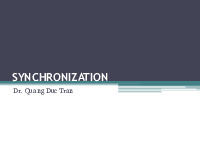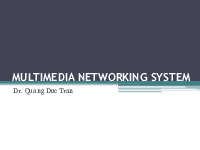



















Preview text:
TEXT & TEXT COMPRESSION Dr. Quang Duc Tran Various Types of Text
• Unformatted text (i.e., plain text) enables pages to be
created, which consist of strings of fixed-sized characters from a limited character set
• Formatted Text (i.e., rich text (RTF)) enables pages to be
created, which consist of strings of characters of different
styles, sizes and shape with tables, graphics, and images inserted at appropriate points
• Hypertext enables an integrated set of documents (Each
consisting of a formatted text) to be created, which have defined linkages between them ASCII Character Coding 33 control characters Back space, Delete, Escape 95 printable characters
Alphabetic, Numeric, Punctuation A – 1000001 (65)
• The American Standard Code for Information Interchange is
one of the most widely used character sets. Each character is
represented by a 7-bit codeword. ISO/IEC 8859
• ISO/IEC 8859 is a standard for 8-bit character
encodings. It allows positions for another 96 printable characters (Latin alphabets)
• ISO/IEC 8859 is divided into the following parts:
▫ Part 1: Latin-1 Western European
▫ Part 2: Latin-2 Central European ▫ ...
▫ Part 16: Latin-10 South-Eastern European
• Although Vietnamese uses Latin based characters, it
does not fit into 96 positions. Unicode • Two mapping methods
▫ Unicode Transformation Format (UTF)
UTF-8: 8 bit, variable-width length which maximizes compatibility with ASCII
UTF-16: 16 bit, variable-width length
UTF-32: 32 bit, fixed-width length
▫ Universal Character Set (UCS)
UCS-2 is a subset of UTF-16 (ISO 10646): a character is represented
by a fixed-length 16 bits (2 byte). It is used on many GSM networks
when a message cannot be encoded using GSM-7. SMS message is
transmitted in 140 octets, a message using UCS-2 has a maximum of 70 characters.
UCS-4 and UTF-32 are functionally equivalent Unicode (Cont.)
• UTF-8 is the dominant encoding on the World Wide Web
(used in over 94% of websites), uses one byte for the first 128
code points and up to 4 bytes for other characters. The first
128 Unicode code points represent the ASCII characters.
• UTF-16 is used internally by systems, such as Microsoft
Windows (Windows CE/2000/XP/2003/Vista/7/10), Java
programming language and JavaScript. Text Compression • Lossless compression
▫ Statistical compression (e.g., Huffman coding)
▫ Compression using dictionary (e.g., Lempel-Ziv)
• These are intended for compressing natural language
text and other data with a similar sequential structure.
• These are used by general purpose compressors such as zip, bzip2, 7zip, etc.
• Compression rate: approximately ½-2/3 document size Huffman Coding
• Huffman coding: A statistical compression technique,
which was developed by David A. Huffman in 1952. Huffman
coding is not always optimal among all compression methods.
It is replaced with arithmetic coding if better compression ratio is required.
• Huffman coding is in wide use because of its simplicity, high
speed. It is often used as a “back-end” to other compression
methods. DEFLATE (PKZIP algorithm) and multimedia
codes, such as JPEG and MP3 have a quantization followed by the use of Huffman coding. The Basic Algorithm
• Not all characters occur with the same frequency.
• Not all characters are allocated the same amount of space.
• Codeword lengths are no longer fixed like ASCII.
• Codeword lengths vary and will be shorter for the more frequently used characters. The Basic Algorithm (Cont.)
1) Scan text to be compressed and tally occurrence of all characters.
2) Sort or prioritize characters based on number of occurrences in text.
3) Build Huffman code tree based on prioritized list.
4) Perform a traversal of tree to determine all codewords.
5) Scan text again and create new file using the Huffman codes. Examples
• Consider the following text:
BCAACADBDCADAEEEABACDBACADCBADABEABEAAA
• A: 15; B: 7; C: 6; D: 6; E: 5 (39) 0 1 A(15) (24) 0 1 (13) (11) 0 1 0 1 B(7) C(6) D(6) E(5) Huffman Coding: Q&A
• Building a Huffman tree for the sequences: “go go gophers”
“streets are stone stars are not” Adaptive Huffman Coding
• Huffman coding needs a probability distribution as an
input. The method for determining the probabilities is called a
model, which can be static, adaptive or semi-adaptive.
• A static model is a fixed model that is known by both the
compressor and decompressor. Compression of the file
requires two passes, one pass to find the frequency of each
character and construct the Huffman tree, and a second pass to compress the file.
• Static model is not always available (e.g., live audio, video).
Even when available, it could be heavy overhead Adaptive Huffman Coding
• An adaptive model changes during the compression. It
allows building the code as the symbols are being transmitted,
having no initial knowledge of source distribution (one-pass encoding)
• The benefit of one-pass procedure is that the source can be
encoded in real time. However, it becomes more sensitive to
transmission error, since just a single loss ruins the whole code. Huffman Coding Characteristics
• It is a lossless data compressing technique generating variable
length codes for different symbols
• It considers frequency of characters for generating codes
• It has complexity of n.log(n) where n is the number of unique characters
• The length of the code for a character is inversely proportional
to the frequency of its occurrence
• No code is prefix of another code Huffman Coding: Q&A
• Which of the following is true about Huffman Coding?
A. Huffman coding may become lossy in some cases
B. Huffman coding is not optimal lossless codes in some cases
C. In Huffman coding, no code is prefix of any other code D. All of the above
• The character a to h have the set of frequencies as follows: a:1,
b:1, c:2, d:3, e:5, f:8, g:13, h:21. A Huffman code is used to
represent the characters. What is the sequence of characters
corresponding to the 110111100111010? Huffman Coding: Q&A
• A network company uses a compression technique to encode
the message before transmitting over the network. Suppose
the message contains the following characters with their
frequency: a:5, b:9, c:12, d:13, e:16, f:45. Each character in
input message takes 1 byte. If the compression technique used
is Huffman Coding, how many bit will be saved in the message?
• Suppose we have a Huffman tree for an alphabet of n symbols,
and that the relative frequencies of the symbols are 1, 2, 4, ...,
2n-1. Sketch the tree for n=5; for n=10. In such a tree (for
general n) how may bits are required to encode the most
frequent symbol? the least frequent symbol? Arithmetic Coding
• Arithmetic coding is a data compression technique that
encodes data (data string) by creating a code string which
represents a fractional value on the number line between 0 and 1. 1 0.2 0.08 0.072 0.0688 a4 a4 a a 4 a4 4 0.06752 a3 a3 a a 3 a3 3 a2 a2 a a 2 a2 2 a1 a1 a a 1 a1 1 0 0 0.04 0.056 0.0624 Arithmetic Coding: Q&A
• Demonstrate how to encode a sequence of five symbols,
namely BABAB from the alphabet (A, B), using arithmetic
coding algorithm if p(A)=1/5 and p(B)=4/5.
• Using the coding in the previous question as an example,
explain how the arithmetic decoding algorithm works, for
example, how to get the original BABAB back from the compressed result. Arithmetic vs. Huffman • Compression
▫ Huffman is within 1/m of entropy
▫ Arithmetic is within 2/m of entropy • Context
▫ Huffman needs a tree for every context
▫ Arithmetic needs a small table of frequencies for every context • Adaptation
▫ Huffman has an elaborate adaptive algorithm
▫ Arithmetic has a simple adaptive mechanism



